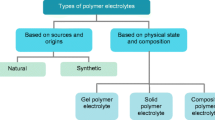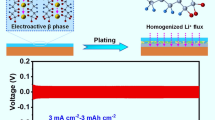Abstract
Investigation of ionic motion in connection with the redox transformation of conjugated polymers (CP) has always been at the leading edge of research. Motivated by recent proofs for the chemical bond formation between chloride ion and α-positioned carbon in poly (3,4–ethylenedioxythiophene) (PEDOT), comprehensive studies have been extended to another strongly electronegative halide (F−) and to another CP, polypyrrole (PPy). As the electrochemical quartz crystal nanobalance (EQCN) results proved, the movement of the bulky Bu4N+ cations has been exclusively experienced during the redox processes of both systems. Moreover, the decisive role of the anions being present in the polymerization solution in determining the redox capacity and, consequently, the maximum doping level of the films was evidenced. On the grounds of the systematic experiments, the strong and permanent chemical interaction of highly electronegative anions and the polymer has been demonstrated as a general phenomenon. Importantly, this observation requires the necessary reconsideration of specific polymer–dopant interactions and calls attention to the necessity of careful design of the polymerization procedure.






Similar content being viewed by others
References
Shirakawa H, Louis EJ, Macdiarmid AG, Chiang CK, Heeger AJ (1977) Synthesis of electrically conducting organic polymers: halogen derivatives of polyacetylene, (CH)x. J Chem Soc Chem Commun 16:578–580
Michalska A, Galuszkiewicz A, Ogonowska M, Ocypa M, Maksymiuk K (2004) PEDOT films: multifunctional membranes for electrochemical ion sensing. J Solid State Electrochem 8:381–389
Bauermann LP, Bartlett PN (2005) EQCM measurements of the ion and solvent flux in thin poly(aniline)–poly(styrenesulfonate) films during redox switching. Electrochim Acta 50:1537–1546
Inzelt G (2008) Conducting polymers. Springer, Berlin
Plieth W, Bund A, Rammelt U, Neudeck S, Duc LM (2006) The role of ion and solvent transport during the redox process of conducting polymers. Electrochim Acta 51:2366–2372
Bund A, Neudeck S (2004) Effect of the solvent and the anion on the doping/dedoping behavior of poly(3,4-ethylenedioxythiophene) films studied with the electrochemical quartz microbalance. J Phys Chem B 108:17845–17850
Marceline NA, Varga A, Latonen RM, Ralph SF, Bobacka J, Ivaska A (2011) Simultaneous monitoring of the transport of anions and cations across polypyrrole based composite membranes. Electrochim Acta 56:3507–3515
Zhou M, Pagels M, Geschke B, Heinze J (2002) Electropolymerization of pyrrole and electrochemical study of polypyrrole. 5. Controlled electrochemical synthesis and solid-state transition of well-defined polypyrrole variants. J Phys Chem B 106:10065–10073
Sonmez G, Schottland P, Reynolds JR (2005) PEDOT/PAMPS: an electrically conductive polymer composite with electrochromic and cation exchange properties. Synth Met 155:130–137
Mangold KM, Weidlich C, Schuster J, Jüttner K (2005) Ion exchange properties and selectivity of PSS in an electrochemically switchable PPy matrix. J Appl Electrochem 35:1293–1301
Heinze J, Bilger R (1993) Ion movements during redox switching of polypyrrole—experiment and simulation. PCCP 97:502–506
Vorotyntsev MA, Vieil E, Heinze J (1995) Ionic exchange of a conducting-polymer film with the solution during the cyclic-voltammetry process. Russ J Electrochem 31:1027–1035
Efimov I, Winkels S, Schultze JW (2001) EQCM study of electropolymerization and redox cycling of 3,4-polyethylenedioxythiophene. J Electroanal Chem 499:169–175
Can M, Sevin F, Yildiz A (2003) The effect of the proton on electropolymerization of the thiophene. Appl Surf Sci 210:338–345
Chiu WW, Travas-Sejdic J, Cooney RP, Bowmaker GA (2006) Studies of dopant effects in poly(3,4-ethylenedioxythiophene) using raman spectroscopy. J Raman Spectrosc 37:1354–1361
Tóth PS, Janáky C, Berkesi O, Tamm T, Visy C (2012) On the unexpected cation exchange behavior, caused by covalent bond formation between PEDOT and Cl− ions: extending the conception for the polymer−dopant interactions. J Phys Chem B 116:5491–5500
Niu L, Kvarnström C, Ivaska A (2004) Mixed ion transfer in redox processes of poly(3,4-ethylenedioxythiophene). J Electroanal Chem 569:151–160
Janáky C, Cseh G, Tóth PS, Visy C (2010) Application of classical and new, direct analytical methods for the elucidation of ion movements during the redox transformation of polypyrrole. J Solid State Electrochem 14:1967–1973
Krische B, Zagorska M (1989) Overoxidation in conducting polymers. Synth Met 28:257–262
Refaey SAM, Schwitzgebel G, Schneider O (1999) Electrochemical impedance studies on oxidative degradation, overoxidative degradation, deactivation and reactivation of conducting polymers. Synth Met 98:183–192
Otero TF, Márquez M, Suárez IJ (2004) Polypyrrole: diffusion coefficients and degradation by overoxidation. J Phys Chem B 108:15429–15433
Visy C, Lukkari J, Pajunen T, Kankare J (1989) Effect of anions on the transient redox behavior of polypyrrole in anhydrous acetonitrile. Synth Met 33:289–299
Visy C, Lukkari J, Kankare J (1997) Change from a bulk to a surface coupling mechanism in the electrochemical polymerization of thiophene. Synth Met 87:81–87
Skompska M, Jackson A, Hillman AR (2000) Evolution from gravimetric to viscoelastic response of poly(3-methylthiophene)-loaded acoustic wave resonators. PCCP 20:4748–4757
Hillman AR, Daisley SJ, Bruckenstein S (2007) Kinetics and mechanism of the electrochemical p-doping of PEDOT. Electrochem Commun 9:1316–1322
Sakmeche N, Aeiyach S, Aaron JJ, Jouini M, Lacroix JC, Lacaze PC (1999) Improvement of the electrosynthesis and physicochemical properties of poly(3,4-ethylenedioxythiophene) using a sodium dodecyl sulfate micellar aqueous medium. Langmuir 15:2566–2574
Acknowledgments
This work has been sponsored by the National Development Agency (NFÜ) under contract no. TÁMOP-4.2.2.A-11/1/KONV-2012-0047.
Author information
Authors and Affiliations
Corresponding author
Rights and permissions
About this article
Cite this article
Tóth, P.S., Endrődi, B., Janáky, C. et al. Development of polymer–dopant interactions during electropolymerization, a key factor in determining the redox behaviour of conducting polymers. J Solid State Electrochem 19, 2891–2896 (2015). https://doi.org/10.1007/s10008-015-2791-1
Received:
Revised:
Accepted:
Published:
Issue Date:
DOI: https://doi.org/10.1007/s10008-015-2791-1




